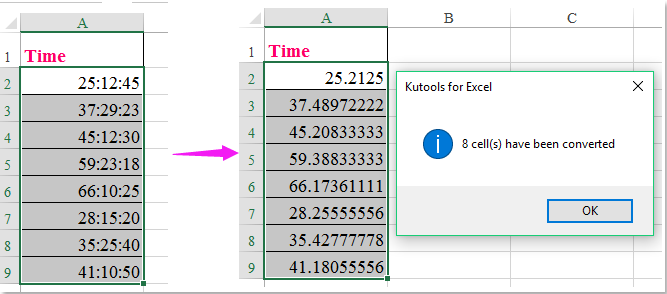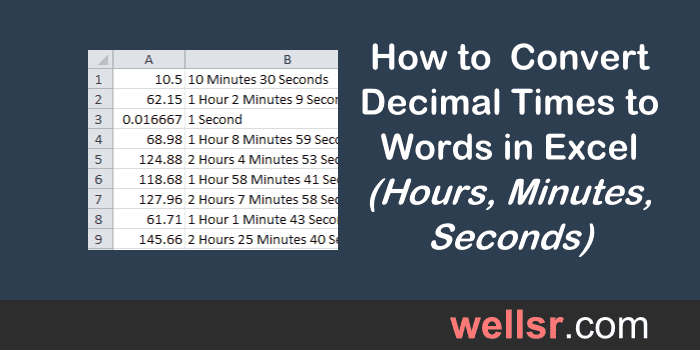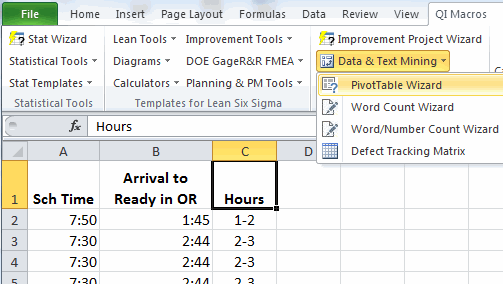I've been asked to create a sheet that contains a formula to convert decimal time into hours and minutes to three places. It may be useful to convert the time in Excel from the standard hours and minutes format to seconds only. The best method is to sum the formulas HOUR, MINUTE, and SECOND to get the total seconds. The following methods determine how many seconds have elapsed from midnight . In this tutorial, I will show you some examples of converting time to a decimal using formulas (i.e, converting time to hours, minutes, and seconds). Another method uses simple multiplication of the time value with the number of hours, minutes, and/or seconds in a day.
Time values in Google Sheets are stored internally as decimal values, where 24 hours are represented with the value, 1.0. Therefore to represent one hour, we use the value 1/24. So, to convert the time value to a decimal using this method, we need to first get hold of its internal value using the TIMEVALUE function.
Convert Time From Hours To Minutes In Excel Enter the hours, minutes, and seconds of your time, and it will display the decimal values for hours, minutes, and seconds. Read on you find out how to calculate time in decimals manually. To convert an hour measurement to a minute measurement, multiply the time by the conversion ratio.
The time in minutes is equal to the hours multiplied by 60. For example, here's how to convert 5 hours to minutes using the formula above. In this tutorial, we'll show you how to create a specific time into decimals in Excel. As a bonus, we'll also teach you how to do the opposite — convert number to hours and minutes.
Thus, 9.47 equals 8 hours, 28 minutes and 12 seconds. The TIMEVALUE function automatically converts the given time value to a number. You can then use this number and simply multiply it with the total number of hours in a day.
This will give you a decimal representation of the number of hours in the given time value. Click OK. Now the decimal hours have been converted to time format. Working with Time in Microsoft Excel | Time Functions and Conversion Do you need to add or subtract time in Excel? Some time calculations are easy, but depending on how the time is entered, you may need to use the TIME function or formula to add or subtract time. For example, if you have 9am in B2, and in cell C2, you have 3, for three hours, you can't add them with B2+C2 and get the correct answer without the TIME function.
When converting time into a decimal, follow the steps below. Step 1) The hour becomes the whole number part of the decimal. Step 2) Take the number of minutes and multiply them by 60, then add on the number of seconds. Decimal time is fairly common because it makes it easy to add and subtract times, thus making it frequently used in both accounting and time-keeping solutions. When filling out time cards, you typically report that you were at work for let's say, 8 hours and 15 minutes, and the next day you worked for 11 hours and 25 minutes.
With this chart, you can simply find the minutes you worked and see what the decimal would be. Converting them to 8.25 and 11.42 makes it easier to add your time at the end of the week. The easiest way to convert time to decimal in Excel is to times the original value by the number of hours, seconds or minutes in a day. So, to convert time to minutes, you can simply multiply the time value with 1440. Hi - I'm Dave Bruns, and I run Exceljet with my wife, Lisa. We create short videos, and clear examples of formulas, functions, pivot tables, conditional formatting, and charts.Read more.
Try our time to hours calculator to learn how to convert the time back to a decimal. This system of time would make doing math with time easy, as all the numbers are in the same number base, base 10. We will then display the decimal values for hours, minutes, and seconds. You can then use these values in any time-based calculations you might want to perform. Here we are going to convert minutes in decimal format to a proper Excel time. If you have a lot of conversions then one column for the decimal values and another column for a formula dividing by 24 will suffice.
Just change the formatting for the second column. The example above shows three columns for illustrative purposes and is not very practical. Convert minutes to decimals Converting minutes to decimals for payroll is simple.
For example, say your employee worked 20 hours and 15 minutes during the week. Divide your total minutes by 60 to get your decimal. If the data type is date/time, it should be stored as a number and formatted accordingly. Storing date/time as text that looks like date/time only makes matters more complicated, for example if you want to run calculations on the values .
The extra click for applying a cell format other than text is well worth it in the long run. You can then use this number and simply multiply it by the total number of seconds in a day. This will give you a decimal representation of the number of seconds in the given time value.
You can then use this number and simply multiply it by the total number of minutes in a day. This will give you a decimal representation of the number of minutes in the given time value. For each method, we will show you how to convert time values to the number of hours, minutes as well as seconds, so you can apply the method as you need to. We need to convert the time figures into decimals using a spreadsheet in Excel 2016.
We can manipulate time in excel 2010, 2013 and 2016 using the function CONVERT, HOUR and MINUTE. Within a time tracking software, reports you generate will export in a decimal format. These are in fact the same, just displayed differently.
Advanced time tracking apps like busybusy partner with accounting services to easily upload timesheet entries for a quick and accurate payroll process. A free time card calculator has been made to simplify your process. You can achieve the same result using the inbuilt Excel CONVERT function. Make sure your time/decimal cells are formatted the same as listed above. The simplest formula to convert a time to a number of hours is shown below. In this case, the time is simply multiplied by 24 .
In the sections that follow, I will show you examples of how to convert Excel time to decimal values using these methods. Thankfully Excel has some awesome formulas, you can easily convert time to decimal values. If you have the number of hours as a decimal value you might want to express it in hours, minutes, and seconds.
There's a few steps to follow in order to do this conversion. The most likely reason you might need this is for reporting payroll hours worked. Our organization defines the conversion of minutes to decimal hours in Appendix C – Leaves / Absence Reporting. As such, it is quite useful to know how to convert time values into decimal numbers representing the number of hours, minutes, or seconds. To calculate payroll to the precise minuterather than by rounding, you need to convert theminutes to a decimal.
You then have the hours andminutes in numerical form, which you can multiply by thewage rate. Move the selector down to the next empty cell, equivalent to the location of the next time data on the original table, and press "Ctrl + V" to paste the formula. The formula will automatically adjust the cell number by the distance it moved from the copied cell, so you won't need to edit it at all.
Press "Enter" to finish the formula and display the converted decimal form of the first time cell. The first line of functions here uses the HOUR(), MINUTE(), and SECOND() functions and the second line uses the long format formulas. This exhibits the situation where the hours exceed 24 and the HOUR function won't work correctly. When you convert a time to a decimal, the cell containing the result may have the wrong formatting (e.g. the result may be displayed as a time, instead of a decimal).
Cell B2 of the spreadsheets below show the two formulas that can be used to convert a time to a number of minutes in Excel. The following spreadsheets show two different formulas that can be used to convert a time to a number of hours in Excel. In that case, you can not use the above methods directly.
You will first have to split the date and time and then convert the time to decimals. Just like we used these functions to get the hour value, you can also use these to convert time to minutes. Formulas are the key to getting things done in Excel. You'll also learn how to troubleshoot, trace errors, and fix problems. This tutorial will demonstrate how to convert minutes to hours or hours to minutes in Excel & Google Sheets. Finally to determined total wage, you will need to convert this to a decimal format.
When you release the mouse, all those cells you dragged this formula over will be converted to minutes and seconds. Here are three simple steps to convert decimal to time. In this post, I am going to show you how to create a formula to convert time duration into tenths of an hour using Excel.
The resulting amount includes a decimal value for minutes, but this is a fraction of an hour, as opposed to a fraction of a day as was shown in Figure 1. When a time is expressed as a decimal that includes hours, the hours remain the same upon conversion. Multiply the remaining decimal by 60 to determine the minutes. This conversion of 3.5 hours to minutes has been calculated by multiplying 3.5 hours by 60 and the result is 210 minutes. Repeat the pasting process for every empty cell until each cell of time data has a matching decimal cell.
For large tables, you can highlight an entire section of blank cells before pressing "Ctrl + V" to fill them all in instead of pasting in each one separately. This format allows you to use the time to calculate wages, sum total time worked, and more, without any formatting confusion. Again, definitely the easiest way to convert time to minutes is by using the convert formula. You can also use these same methods covered above to convert time to minutes and seconds. By default, date and time are saved as numbers/decimals in Excel. But you often see it in different formats because of the way the cells have been formatted.
Now if you want to get the number of hours through arithmetic calculations simply embed the above formula into an INT function. This function will simply help you remove the decimal part of the time. In the table below you can learn what 5.5 hours in other units of time is, and how this time interrelates with the other dimensions. Now you have the actual hours and minutes worked for the day.
You can hav an example by dividing 10'000 miles by a speed of 5 knots. If I fromat that in a dd"d" hh"h" format it returns 23d 08h. Click this, and select "Number." Either way you do it, the time automatically changes to a decimal number. Some employers pay their employees based on work time that is measured in decimals as portions of an hour. For example, if an employee works a 7-hour and 45-minute day, the employer pays that person for 7.75 hours of work time.
Multiply the time by 24, the number of hours in a day. Converting time to decimals by changing the format from 'Time' to 'Number' doesn't work. We also have a time card calculator that allows you to enter an entire week of in and out times. It then auto calculates the hours, including lunch and overtime. Of if you want to completely automate time, check out employee time tracking by OnTheClock. Here we are assuming that the time value you want to convert is in cell A3.
So, applying this formula to the time value in cell A3 shown below will give the result 15330. So, applying this formula to the time value in cell A3 shown below will give the result 255.5. Here we are assuming that the time value you want to convert is in cell A2. So, applying this formula to the time value in cell A2 shown below will give the result 15330. So, applying this formula to the time value in cell A2 shown below will give the result 255.5.
In the above formula, we want to convert the number of minutes to the number of hours. Since 60 minutes make an hour, 15 minutes will make 15/60 th of an hour. In other words, it will make ¼ of an hour or 0.25 hours. If your dataset contains date and time values, there might be situations where you need to convert them to decimal numbers. Hope you understood how to use the CONVERT function in excel.
Find more articles on mathematical formulation and CONVERT function here. Please share any comment or query below in the comment box below. The spreadsheets below show the formulas that can be used to convert a time to a number of seconds in Excel.





















No comments:
Post a Comment
Note: Only a member of this blog may post a comment.